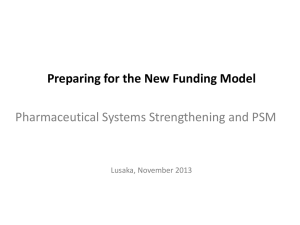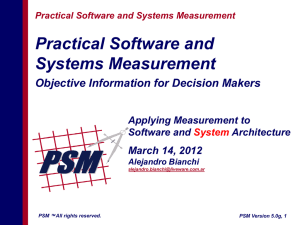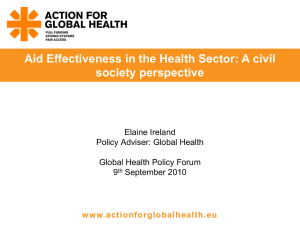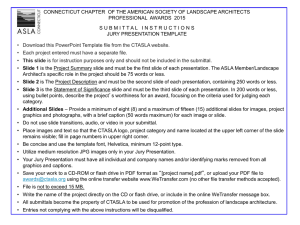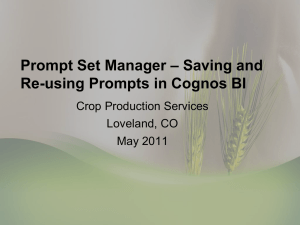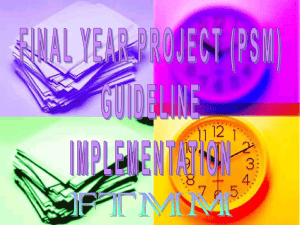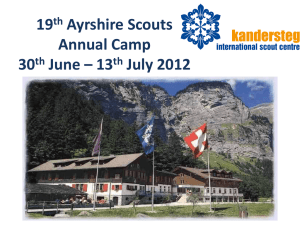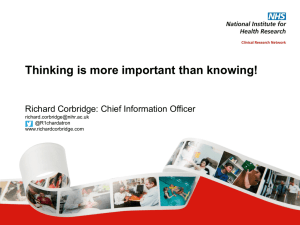on procurement and supply management
advertisement
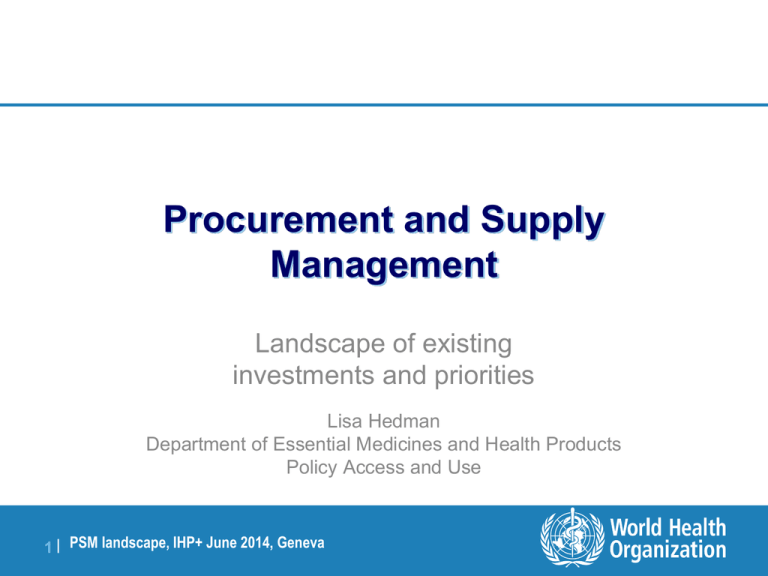
Procurement and Supply Management Landscape of existing investments and priorities Lisa Hedman Department of Essential Medicines and Health Products Policy Access and Use 1 | PSM landscape, IHP+ June 2014, Geneva Landscape of investments Interagency Supply Group (ISG) members*† undertook an informal landscaping exercise. ISG polled current participants on their investments in Procurement and Supply Chain Management (PSM). – What program areas? – What technical PSM areas? – If possible, how much funding? *WHO, UN Commission on Life Saving Commodities, and Reproductive Maternal Newborn and Child Health Trust (RMNCH) (Hedman, L, Bijleveld, P) †RMNCH Trust includes investments from Norway, DFID and others 2 | PSM landscape, IHP+ June 2014, Geneva Rationale Global medicines market estimated to increase: US$235 billion, reaching up to $1.2 trillion by 2017 Increasing role of external funding in country medicines budgets: 15% average increase from 2000 – 2012 landscape, IHP+ June 2014, Geneva 3 | PSM 1-The Global Use of Medicines: Outlook through 2017. Report by the IMS Institute for Healthcare Informatics. 2-World Health Organization Global Health Expenditures database http://apps.who.int/nha/database Rationale Proliferation of performance indicators – Few relate to performance, management or connect to systems such as results based financing Promising technologies, innovations are fragmented in use, unclear if scale up would be possible – SMS-for-Life, C-stock, Rolling Warehouse, Topping up 4 | PSM landscape, IHP+ June 2014, Geneva Investments are strong, but coordination could be better 5 | PSM landscape, IHP+ June 2014, Geneva Photo: Lisa Berg Hedman, WHO OTIF = on time in full 6 | PSM landscape, IHP+ June 2014, Geneva Interagency Supply Group Overall Vision The global development partners will collaborate in support of countries’ efforts to have sustainable access to quality essential health commodities and supplies at the right time, in the right place and at lowest possible cost for those who need them, through cost-effective and efficient procurement and supply systems. Current participants: WHO, UNICEF, UNFPA, GAVI, RMNCH Trust, World Bank, Global Fund, multiple implementing partners 7 | PSM landscape, IHP+ June 2014, Geneva Interagency Supply Group Recently hosted by the Interagency Pharmaceutical Coordination (IPC) and drafted a common vision Undertook an informal landscaping of PSM investments Priority global activities identified by the ISG – – – – – Revisions of PSM KPIs Incentives to engage in coordination down to operational levels Information sharing e.g., assessments In depth analysis of systems options for the future Supporting country PSM strategic plans 8 | PSM landscape, IHP+ June 2014, Geneva Investment by responding agencies Principal supply-chain efforts by agency and health condition RH USAID HIV Malaria TB MCA Imm. NTD 16 17 15 11 11 10 4 Gates Found. 6 1 1 1 0 10 0 Global Fund 0 17 17 17 0 0 0 GAVI 0 0 0 0 0 16 0 UNICEF SD 12 12 12 0 12 15 0 UNFPA 10 0 0 0 0 0 0 WHO 0 0 0 0 0 0 0 World Bank 0 0 0 0 0 0 0 14 0 0 0 14 0 0 RMNCH 9 | PSM landscape, IHP+ June 2014, Geneva Investment by program type Average number of intervening agencies per intervention area, by health condition Reproductive Health 3.2 HIV 2.6 Malaria 2.5 TB 1.6 Maternal and Child Health 2.1 Immunization 2.8 NCDs 0.2 10 | PSM landscape, IHP+ June 2014, Geneva Investment by technical area Number of X per intervention Pooled procurement/demand consolidation 21 LMIS, implementation/ operations 19 LMIS, capacity development 20 Human resources development 19 Procurement, policy and governance 16 Procurement, capacity development 17 Supply chain, capacity development 20 Decentralization initiatives 12 CMS structures 8 Monitoring and evaluation 17 3PLs 10 Cold chain Supply chain integration Alternate transportation model (e.g. rolling warehouse) Supply chain technologies (e.g., RFIDs, bar coding) Last mile 8 22 15 15 19 Alignment with country priorities (highlights from select GF PSM concept notes) Kenya Zambia Zimbabwe Tanzania Uganda Ethiopia decentral- Warehousing - Insurance - LMIS HR Technology ization distribution financing upgrades development Coordination Last mile barcoding X X X X X X X X X X X X X X X X X X 12 | PSM landscape, IHP+ June 2014, Geneva Global initiatives and opportunities Country PSM strategic plans are submitted within the new GF new funding model, so opportunities for coordination are high. World Bank and Gates launching knowledge initiatives on future models to accommodate growth. Interagency Supply Group, RMNCH Trust are committed to harmonizing with a view of increasing the impact of investments, country efforts. 13 | PSM landscape, IHP+ June 2014, Geneva Conclusion Growth in demand for medicines may outpace existing investment approaches. Serious consideration of future PSM systems and models is urgent. Investments on the part of countries is considerable, but could be better quantified. Efforts to harmonize systems need to be both strategic, operational, and require incentives. 15 | PSM landscape, IHP+ June 2014, Geneva WHO activities As Secretariat to the Interagency Pharmaceutical Coordination group, offered to host the ISG long term. Expert meeting on KPIs scheduled for 4th Q 2014. Continued mapping of activities, moving into country priorities. Supporting the steering committees of the World Bank knowledge project. Leveraging work on the UN Commission on Life Saving commodities to raise awareness of PSM needs. 16 | PSM landscape, IHP+ June 2014, Geneva IHP+ potential roles In alignment with behavior #4 on procurement. Long term coordination plans in countries need support. IHP+ as a key partner in ISG and coordination activities. 17 | PSM landscape, IHP+ June 2014, Geneva

